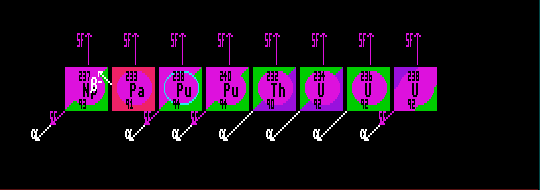

Whereas normally, such an excited metastable nucleus would, within a certain time depending upon the halflife, release this extra internal energy by undergoing an internal transition and emitting a gamma ray, a fertile nucleus also becomes liable to spontaneous fission when so excited. In books, such nuclides are designated by an 'f' as in U-236f, where the 'f' means it is in an excited fissionable state (as opposed to an 'm' meaning metastable from which only a radiative isomeric transition decay to the ground state is possible). Uranium-236f can decay by either spontaneous fission (12% probability) or by isomeric transition (88% probability).
The following are fertile nuclides : neptunium-237, protactinium-233, plutonium-238, plutonium-240, thorium-232, uranium-234, uranium-236 and uranium-238, all shown above.
Fissile nuclides, on the other hand, are nuclides that can readily be induced into fission by the absorption of a slow neutron. Examples are Plutonium-239 and Plutonium-241.
![]()